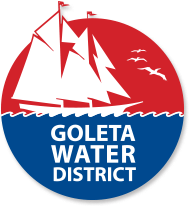The District's Distribution System
The Goleta Water District delivers quality water to 87,000 customers throughout the Goleta Valley. Over the past 75 years, the District has invested millions of dollars to build, sustain, and improve its distribution system, which delivers that water from Lake Cachuma, the State Water Project, the Goleta Groundwater Basin, and the recycled water system.
How does the potable distribution system work?
The District’s distribution system consists of 270 miles of pipeline, 8 water storage reservoirs, 6 pump stations, 9 groundwater production wells, 6,500 valves, and 17,200 service connections. In addition, the District maintains 1,550 fire hydrants throughout the community.
Water flows downhill from Lake Cachuma into the Tecolote Tunnel and on to the South Coast Conduit. This conduit then feeds the Corona Del Mar Water Treatment Plant where water is treated at a rate of up to 24-million-gallons-per day. Treated water then enters two large transmission mains, which run downhill through a series of smaller pipes that branch out to fill the District storage reservoirs and reach all areas of the District’s service territory. In this sense the District’s distribution system resembles the human arterial system, with several major arteries feeding into smaller capillaries.
Each Goleta Water District customer is connected to the distribution system through a service line that supplies water through a meter located at the customer’s property. Meters track the usage for billing purposes and are also helpful to detect leaks on the customer’s property.
Though the system is largely gravity based with 98% of the water being delivered downhill, the District also relies on 6 pump stations to serve customers at higher elevations and to move water from the District’s groundwater production wells. These pumping facilities range up to 2,500 gallons per minute and are located throughout the distribution system. Pumps use electric energy to push water against gravity from low to high elevations with a series of impellers, motors, and valve components. These mechanical systems are operated and maintained at an annual cost in the hundreds of thousands of dollars.
How does the District maintain pressure in the system?
There are 8 water storage reservoirs located at higher elevations throughout the distribution system. These reservoirs are large tanks that supply the District’s pressure zones and balance supply and demand from day to day. Tank storage also provides a back-up supply of water for community fire-fighting needs and enough water to offset short duration supply outages.
Goleta Water District’s potable water system is unique in that it is over 98% gravity-fed. System pressures are maintained at various elevations through a series of pressure reducing valves located throughout the distribution system. A network of line valves also allow distribution operators to control and isolate portions of the distribution system during emergency repairs and scheduled maintenance. These valves also reduce the number of customers affected by service outages. Finally, the distribution system also includes a hydro-kinetic turbine that generates electricity, which offsets District power costs.
What future challenges does the District anticipate?
Water utilities across California and the nation are dealing with rising costs to replace infrastructure. The District recently celebrated its 75th anniversary, and nearly 71% of the District’s pipes are older than 50 years. Due to wear, corrosion, and age the District currently spends approximately four hundred thousand dollars per year on emergency repairs and main breaks. The approximate cost of pipe replacement can range from one to three million dollars per mile. Because full infrastructure replacement is financially infeasible, prudent capital planning to target the most critical replacements is essential to sustaining the system moving forward.
As we look to the future, continued distribution system maintenance, enhancement and replacement will ensure the long term viability of quality water delivery to customers in the Goleta Valley.
(Published January 22, 2020)

